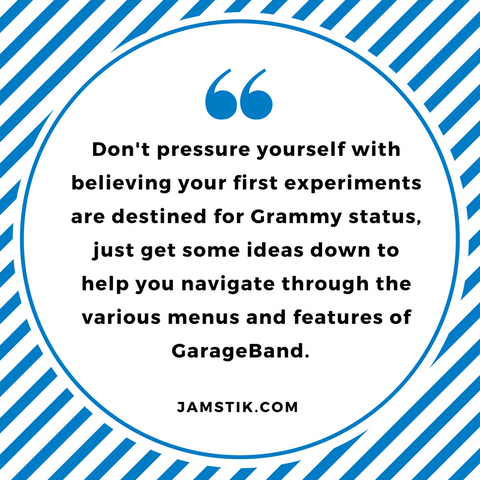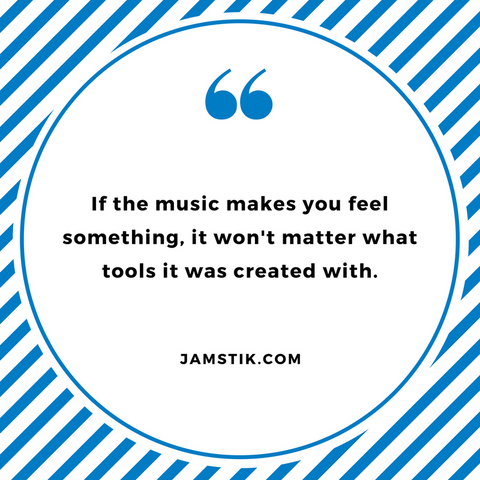If you haven't already seen Wired's piece on Steve Lacy—he's the hip-hop producer with a track on Kendrick Lamar's latest release, and he does everything on his iPhone—You should give it a read here: "The Hot New Hip-Hop Producer Who Does Everything On His iPhone"
Here's what should be screaming off the screen at you as you read the article from Wired:
"Lacy’s smartphone has been his personal studio since he first started making music. He’s also working this way to prove a point: that tools don’t really matter. He wants to remind people that the performance, the song, the feeling matter more than the gear you use to record it. If you want to make something, Lacy tells me, grab whatever you have and just make it. If it’s good, people will notice. Maybe even Kendrick Lamar."
- David Pierce for Wired
Did you get that? Let it sink in and inspire you for a moment. What counts, and what's really important at the end of the day, is not the expensive studio you paid hourly to record the drums, or the uber-high-end analog-to-digital converter package that cost you $2000 to connect to $1000 software. What's important is this — The music, does it move you? Does it move others?

Steve Lacy, the Kendrick Lamar producer who works from his iPhone, understands this very well. So well, in fact, that he's staked his creative career on it. He's managed to keep the "main things" the priority, and not make mountains out of molehills. If the music makes you feel something, it won't matter what tools it was created with.
If you're a jamstik user, this should have some inspirational power for you. You're working with similar tools as musical hit makers. That should kick up your inspiration levels a couple of notches and motivate you to start collecting your ideas and writing songs on your iPhone or iPad.
If you're wondering how exactly you can do this yourself, we're going to help you with tutorials and suggested app blogs right here on jamstik.com. We'll even recommend audio and MIDI hardware just so you can be educated about your choices. For example, you CAN use your iPhone or iPad mic to record vocals or ambient sounds, but you might want a microphone. We'll let you know what we've used in the past, and pass along our suggestions.
First things first — if you've never worked with GarageBand, you'll need to get familiar understanding the interface and basic recording concepts.
This video from Technology for Teachers and Students is a solid overview of how things work in GarageBand for iOS:
If you need to bring yourself up to speed on jamstik+ and puc+ integration with GarageBand, this video will get you off and running:
If you're already familiar with GarageBand, but you want to get caught up on a specific topic, the links to the various topics covered in the above video are:
- Where to connect jamstik+ & puc+?
- Use with Music Apps?
- EQ & Compression
- Live Loops
- Drummer
- Sounds & Loops
A very common question nearly every jamstik+ user asks early on in their GarageBand experience is:
"Why doesn't every note on the jamstik trigger a sound in the GarageBand drum kits?"
It's a fair question, but answering it is a deeper dive than just telling you "you'll understand when you get older." This blog will help you understand the whole MIDI-drums/GarageBand-drums/jamstik mystery: "How To Play Drumkits with the jamstik" There's a video linked in there (which is better than a reading novel with pretty pictures, so go ahead and check it out!)
So, having watched some video and read our supporting blog entries, you need to put your new knowledge into practice.

The best thing you can do is to get started recording some MIDI tracks using the GarageBand instruments.
I suggest that anyone who is getting acquainted with any recording software focus on recording and editing/tweaking CASUAL performances. Don't pressure yourself with believing your first experiments are destined for Grammy status, just get some ideas down to help you navigate through the various menus and features of GarageBand.

Psychologically speaking, your "creative" brain - where the music comes from - is not your "technician" brain.
Your technician brain needs to be able to take a back seat to the creative when the time calls for it. You'll want to be familiar enough with the in's and out's of operating GarageBand so your creative flow isn't interrupted or distracted by having to remember or search for "how to's" if you can avoid it.
Have fun, don't knock yourself out worrying about perfection. Get the process down so you won't have to think about it too much later when you're going to be creative. You want to be able to hit a flow with as few interruptions as possible the further you go.
GarageBand now has a very healthy selection of sounds available.
You can stay exclusively within GarageBand's stock sounds and make great sounding music, but there are ways to integrate other app's sounds into GarageBand, and you might want to explore your options. (Personally speaking, I like to use drums samples from other apps, and there are great sounding synths in the App Store that I use regularly in GarageBand).
There are three methods for integrating other apps into GarageBand, or vice versa.
— InterApp Audio, Audiobus, and AudioUnit Extensions.
InterApp Audio and Audiobus are very similar technologies that connect the audio output from one app into another. InterApp Audio is Apple's on-board technology within iOS, Audiobus is a third-party app which predated InterApp Audio and has a few additional refinements. AudioUnit Extensions is still an "early adopter" feature for iOS developers, so you'll see fewer options available - but AudioUnit Extensions work more like software plugins in a DAW.
Hopefully, more AudioUnit Extension enabled apps are around the corner. We'll dive into InterApp Audio, Audiobus, and AudioUnit Extensions at a later date. For the time being, if you're interested in experimenting with InterApp Audio or Audiobus you can see read our blog tutorial on "How To Use jamstik+ Sounds in GarageBand with Audiobus" or watch the video below.
So what are some of our favorite apps to integrate into GarageBand sessions?
Here's a list of some compatible jamstik+ apps that we've done video reviews of:
M3000 for iPad
- M3000 — Free Edition for iPad
- M3000 Ultimate Edition — $74.99 for iPad
- M3000 50th Anniversary Edition — $11.99 for iPad
Animoog
BeatHawk
- BeatHawk — $9.99 for iPad and iPhone
SampleTank
- SampleTank — $19.99 for iPad and iPhone
This is just a small sample of the apps we really like to use. If you're the type that likes to know a ton of options for sounds, we've got you covered. Check out this list of iPad and iPhone apps that are compatible with the jamstik+!
iPad & iPhone Compatible jamstik+ Apps:
- iVCS3 Official EMS VCS3 emulator — $14.99 for iPad & iPhone
- Magellan modeling synthesizer — $14.99 for iPad, $4.99 for iPhone
- BeatMaker 2 — $9.99 for iPad and iPhone
- iVoxel vocoder — $6.99 for iPad & iPhone
- iMPC by Akai Professional — $6.99 for iPad, $2.99 for iPhone
- Cassini Synthesizer by iceWorks— $5.99 for iPad, $3.99 for iPhone
- Arctic Keys — $4.99 for iPad & iPhone
- e-l-s-a — $1.99 for iPad & iPhone
iPad Only — Compatible jamstik+ Apps:
- KORG iPolysix synthesizer — $29.99 for iPad
- KORG iMS-20 analog synth studio — $29.99 for iPad
- NAVE — $19.99 for iPad
- ReBirth Drum Machines by Propellerhead — $14.99 for iPad
- Sunriser Synth — $9.99 for iPad
- Microtera — $9.99 for iPad
- iMini Synthesizer by Arturia — $9.99 for iPad
- iSem Synthesizer by Arturia — $9.99 for iPad
- BOOM 808! — $1.99 for iPad
- Tabletop — FREE for iPad
Ok, that's a TON of stuff to assimilate and digest. Go get excited about what's ahead and get yourself prepared on how this all works.

Once you start creating you'll want to keep the vibe flowing, and knowing as many of the ins and outs of the technical aspects will keep you from having to stop and search. Stay tuned, because we want to cover as much as you're down for!
To stay up-to-date on music production tips with the jamstik+, make sure to follow us on social media and subscribe to our newsletter!



Share:
Helpful Tips for Using SONAR with the Jamstik+
Generating tablature and notation with the Jamstik and Guitar Pro!